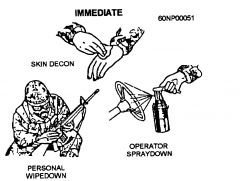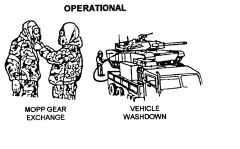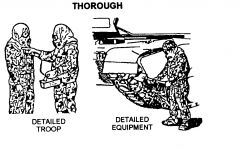![]()
![]()
![]()
Use LEFT and RIGHT arrow keys to navigate between flashcards;
Use UP and DOWN arrow keys to flip the card;
H to show hint;
A reads text to speech;
40 Cards in this Set
- Front
- Back
|
110.1
Chemical Warfare |
- Produces physiological and psychological effects
- solid, liquid or vapor form |
|
|
110.1
Biological Warfare |
- Intentional release of living organisms or substances to cause death or disease
|
|
|
110.1
Radiological Effects |
- Nuclear weapons produce explosions of great force or heat
|
|
|
110.1
Routes by which agents enter the body |
- Inhalation, ingestion, injection, absorption
|
|
|
110.2
MCU-2/P |
MCU-2/p currently being replaced by the M50 Joint Service General Purpose Mask
- gas masks (protects eyes, face, nose, throat, lungs) - quickest and most effective means to protect yourself |
|
|
110.2
CHEMICAL PROTECTIVE OVERGARMENT |
- Two piece suit that protects against all KNOWN chemical and biological agents
- The chemical protective garmet is NOT tobe used for radiological contamination |
|
|
110.2
WET-WEATHER CLOTHING |
- Provides complete protection against alpha/beta radiological contamination when worn with
battle dress and anti-flash gear - Provides an extra layer of protection for the chemical protective over garment by keeping it dry. |
|
|
110.2
ATROPINE / PRALIDOXIME CHLORIDE (OXIME) |
- Used to counteract, and relieve the symptoms of nerve agents only
|
|
|
110.2
POCKET DOSIMETER |
- Size and shape of a fountain pen
- Measures exposure to radiation over a period of time |
|
|
110.3
Chemical warfare agents and their physical symptoms: CASUALTY |
- Casualty : Nerve, Blister, Choking and Blood.
|
|
|
110.3
Chemical warfare agents and their physical symptoms: INCAPACIATING |
- Incapacitating : Symptoms vary
|
|
|
110.3
Chemical warfare agents and their physical symptoms: HARASSING |
- Harassing : Tear and vomiting gases
|
|
|
110.4
NUCLEAR EXPLOSION: AIRBURST |
- Fireball does not touch the earth
|
|
|
110.4
NUCLEAR EXPLOSION: SURFACE BURST |
- Fireball touches the earth; produces large amounts of fallout
|
|
|
110.4
NUCLEAR EXPLOSION: UNDERWATER BURST |
- Large base surge is formed which billows up several hundred feet
|
|
|
110.5
Effects of nuclear explosion: Nuclear radiation |
- Alpha / Beta particles: taken into body by ingestion or cuts
- Gamma Rays: pure energy and not easily stopped; penetrates every region of the body - Neutrons: greatest penetrating power |
|
|
110.6
Mission Oriented Protective Posture (MOPP) |
MOPP:
Flexible system for protection against chemical agents; facilitates mission accomplishment in chemical warfare. |
|
|
110.6
MOPP 0 |
Carry MOPP gear at all time
|
|
|
110.6
MOPP 1 |
Don CBR smock and trousers
|
|
|
110.6
MOPP 2 |
Don protective overboots
|
|
|
110.6
MOPP 3 |
Don chemical masks
|
|
|
110.6
MOPP 4 |
Don chemical cotton liners and gloves
|
|
|
110.8
Describe the colors and markings on the North Atlantic Treaty Organization (NATO) Biological, Chemical, and Radiological (CBR) Marker Signs. Chemical Marker |
Yellow background with red lettering
|
|
|
110.8
Describe the colors and markings on the North Atlantic Treaty Organization (NATO) Biological, Chemical, and Radiological (CBR) Marker Signs. Biological Marker |
Blue background with red lettering
|
|
|
110.8
Describe the colors and markings on the North Atlantic Treaty Organization (NATO) Biological, Chemical, and Radiological (CBR) Marker Signs. Radiological Marker |
White background with black lettering
|
|
|
110.9
Describe the color that the M-9 paper turns after it comes in contact with a liquid nerve or blister agent. |
- Detects the presence of liquid nerve and blister agents
- If spots or streaks on the paper appear pink, red-brown, red-purple, or any shade of red, assume it has been exposed to a chemical agent. |
|
|
110.10
Describe the color that M-8 paper turns after it comes in contact with a liquid nerve or blister agent. |
- Detects the presence of liquid nerve and blister agents
- If spots or streaks on the paper appear red, yellow, or green, assume it has been exposed to a chemical agent. |
|
|
110.11
Contents of Nerve Agent Antidote Kit (NAAK) MK1 Auto Injectors |
• 1 ea Atropine – labeled #1, Yellow and green color
• 1 ea 2PAM Chloride – labeled #2, tan color |
|
|
110.11
Treatment (self and buddy aid) Self Aid |
• Don the protective mask
• Remove NAAK from the protective mask carrier • Inject the thigh with the first injector from the kit (Atropine). Hold for 10 seconds • Follow immediately with the second injector (2PAM Chloride) and hold for at least 10 seconds. • Hook the expended auto injectors to the CPE Pocket flap • Massage injection site if time permits • Wait 10-15 minutes before administering second series of injections (no more than three) |
|
|
110.11
Treatment (self and buddy aid) Buddy Aid |
• Mask the Casualty
• Using the NAAK belonging to the victim, administer three sets of injections immediately and in rapid succession in the thigh muscle of the leg. • Hook the expended auto injectors to the CPE pocket flap of the victim • Administer the back pressure arm-lift method of artificial ventilation if breathing is difficult or has ceased |
|
|
110.12
Describe the steps and procedures in utilizing the M-2-95 and M-291 deontamination kits |
- Black, reactive, and absorbent resin powder
- M295 is a larger version of the M291 used for equipment decon |
|
|
110.13
State how long the Joint Service Lightweight Integrated Suit Technology (JSLIST) suit will provide protection from chemical agents once they are removed from the packaging under the following conditions. |
a. Exposed to chemical agents
- 24 Hours b. Not exposed to chemical agents - 45 days |
|
|
110.14
Discuss laundering procedures for the JSLIST |
JSLIST may be laundered up to 6 times within the CBR service life. Do not dry in a machine dryer. JSLIST must be hung to dry.
|
|
|
110.15
Discuss the following types of Decontamination. Immediate |

Used to minimize casualties, save lives, and limit the spread of contamination
|
|
|
110.15
Discuss the following types of Decontamination. Operational |

Used to sustain operations, reduce the contact hazard and limit the spread of contamination
|
|
|
110.15
Discuss the following types of Decontamination. Thorough |

Used to reduce or eliminate the need for individual protective clothing
|
|
|
110.18
State the purpose and the optimum location of the M-22 chemical alarm. |
- Agents detected at a romte location, a warning light and horn provide advanced warning of a chemical warfare attack.
- Optimally placed in upwind locations. |
|
|
110.20
Explain and discuss the following dosimeter equipment: DT-60 / PD |
- Solid state package in the form of a locket designed to be worn on a chain around the neck.
- Gamma Radiation Dosimeter, 10 to 600 R - Stores dose information indefinitely |
|
|
110.20
Explain and discuss the following dosimeter equipment: IM 143 / PD |
- Self reading pocket dosimeter in the shape of a pen.
- Gamma radiation dosimeter, 0 to 600 R - Used to survey, monitoring and decon teams. - Tracks the dose you have received up to the time you read the dosimeter. |
|
|
110.20
Explain and discuss the following dosimeter equipment: CP-95A / PD |
- Radiac computer indicator designed to read DT-60/PD
- Two scales: - 0 to 200 R - 0 to 600 R - Minimum detectable range: 10 R |

